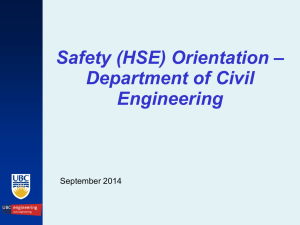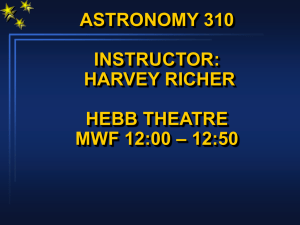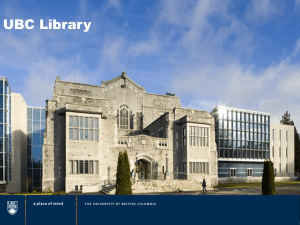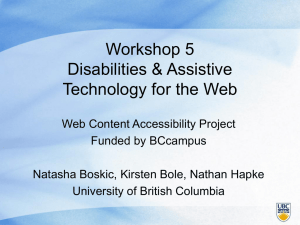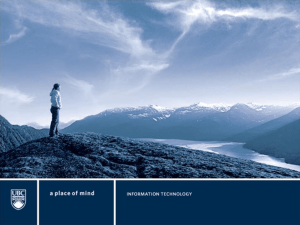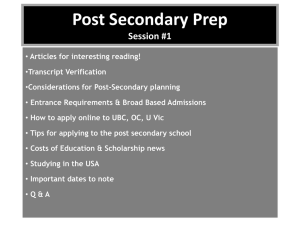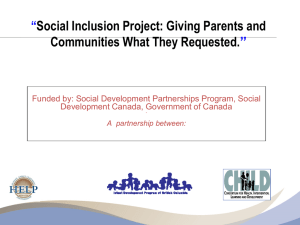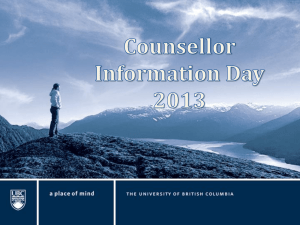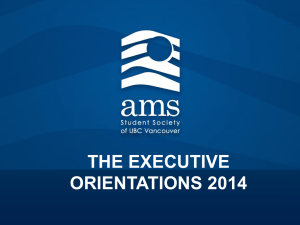Safety - Civil Engineering, Department of
advertisement
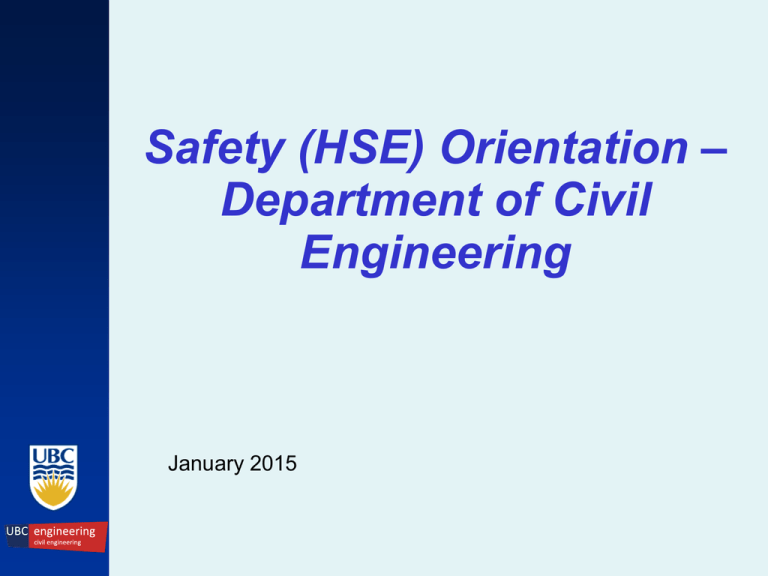
Safety (HSE) Orientation – Department of Civil Engineering January 2015 Session Objectives Understand: • Your role in our safety (HSE) program • How to respond to emergencies • The importance of looking for and reporting hazards • What to do in an earthquake • What is a lockdown and what to do • Ergonomics as applied to your job • Bullying and harassment • Student Safety Abroad Registry • Laboratory Safety Health, Safety and Environment • UBC, as the EMPLOYER, sets policies and supplies the resources to create a healthy and safe work environment • Staff develop and implement safety policies and rules to ensure a healthy and safe work environment • As an EMPLOYEE, you must follow all HSE rules. • As a SUPERVISOR you are responsible for the safety of your reports and that they comply with all HSE rules. ➔ If you are a TA, you are considered a supervisor and the students are your reports HSE in Civil Engineering If you have any questions about safety or would like to report any incident or unsafe conditions, contact the following members of our HSE Committee: Paula Parkinson, Co-chair 2-4397 parkin@civil.ubc.ca Harald Schrempp, Work shop 2-4851 haralds@civil.ubc.ca Scott Jackson, Electronics Sylvia Margraff, Co-chair 2-1212 Louise Fogarty, Civil Office Bernard Laval, Faculty Tyler Best, Student rep 2-4143 scottj@civil.ubc.ca officemanager@civil.ubc.ca 2-4429 2-2204 facsec@civil.ubc.ca blaval@civil.ubc.ca tbest@civil.ubc.ca Your Responsibilities You have the right to refuse to do anything that is unsafe. When working in our Department, follow all safety rules • Ensure you are trained on all equipment you are to use • Check with appropriate personnel for mechanical, electrical and chemical issues Clean up your work area – excellence in housekeeping Know what to do in emergency situations Report any incident or unsafe condition to a supervisor IMMEDIATELY Incident Reported to manager. Email notification of incident to Department Head, SPA, Dept. Safety Specialist. Serious incidents (injuries) are reported to the department head immediately by phone. Procedures in the event of an incident, accident or near miss Final Report to Dept. Head, RMS, worker(s) involved, and SharePoint. Hard copy to file in Safety Manager’s office. Incident or near miss report to RMS HSE committee minutes Investigation, written report Safety committee Review, update, approve Bulletin Boards Workplace Safety Two of the most common causes of workplace incidents and injuries are: Slips, trips and falls due to poor housekeeping …leading to cuts, bruises, sprains and broken bones and Workplace Safety Improper material handling techniques – “lifting and moving stuff ” …leading to back injuries If it’s too heavy, get help or use a jack or crane Proper lifting techniques • Stand close to the load – squat and lift with legs • Avoid picking up heavy loads below knees and above shoulders • Bend at the knees – not at the waist • Keep back straight and keep chin up during lift Housekeeping • Remove trip hazards • Clean up and immediately notify your supervisor of spills • Keep walkways and aisles clear • Keep clear access to: • evacuation routes and emergency exits, • fire extinguishers, • first aid kits • phones and • electrical panels • Close drawers and doors • Dispose of trash promptly and properly Ergonomics • Ergonomic (overexertion and repetitive strain) Injuries make up 35% of all WSBC claims at UBC • Our goal: to eliminate or, if that is not practicable, minimize the risk of musculoskeletal injury (MSI) to workers. • A properly designed workplace, proper technique, and good tools can prevent these types of injuries. The Ideal Workstation Set up ☛ The advent of the laptop has changed the game and increased the risk of MSIs Tips to Remember Use neutral postures Adjust your workstation Keep things within reach Don’t use a laptop as your desktop machine unless you have an external keyboard and raise the laptop Get rid of clutter Take breaks and stretch occasionally Ergonomics Don’t ignore these signs and symptoms Signs Redness Heat Swelling Reduced Range of Motion Symptoms Pain &/or localized discomfort Numbness/Tingling Tender to Touch Stiffness Weakness First Aid • There are first aid kits in most of the labs in the department as well as the workshop and the main office. Familiarize yourself with the nearest location. • You can get First Aid or immediate help by: ☞ ☞ ☞ Dialing 911or Campus First Aid: 604.822.4444 Going to the UBC hospital Getting hold of one of our own First Aid attendants: Sylvia Margraff: 604.822.1212 Loretta Li 604-822-1820 Louise Fogarty: 604.822.4429 Clare Quirk 604-822-5922 Harald Schrempp 604-418-0216 Scott Jackson 604-655-4911 Paula Parkinson 604-363-0897 Emergency Situations When starting to work in an area, learn and memorize the location of: • • • • • • Fire extinguishers and fire alarm pulls Phones All exits First Aid Kits Eye wash stations and/or safety showers The address of the building and your room number Be prepared for emergencies Sign up for UBC ALERT: Update your cell phone number in SIS/HRMS records to allow the University to send you text messages from UBC’s emergency text message notification system. Learn more emergency.ubc.ca/ubcalert Be prepared: Visit emergency.ubc.ca/procedures/earthquake/for resources on being prepared before, during and after an earthquake. Follow the official UBC news channels – ubc.ca and @UBCnews Emergency Situations • The UBC Campus Security has developed several protocols to cover emergency situations. The most recent versions can always be found on their sites: ➪ www.security.ubc.ca ➪ www.emergency.ubc.ca • Emergency Contact Numbers • Fire, Ambulance, Police: 911 • Campus Security: 604.822.2222 • Campus First Aid: 604.822.4444 • Hazardous Materials Response: 911 • Poison Control Centre: 604.682.5050 Lockdown A lockdown is intended to secure and protect occupants who are in the proximity of an immediate threat • A lockdown is used when it may be more dangerous to evacuate a building than stay inside By controlling entry/exit and movement within a facility, emergency personnel are better able to contain and handle the threat Lockdown What do you do? If you are in a classroom, room or office: • Secure the door and windows • Close curtains or blinds where possible. • Stay away from windows and doors. • Be seated (situated) below window level. • Stay low and quiet • Don’t open the door to anyone unless you are sure they are emergency personnel • Await instructions or escort from emergency personnel Emergency situations - Evacuation • If you hear the evacuation alarm (ringing bells): • If possible, shut down equipment and secure hazardous materials • Leave the building immediately, using the nearest safe exit and go to the muster point. Do not run. • Follow the instructions of the Fire Wardens, Campus Security, Police, Fire or Ambulance when asked to evacuate the building. • NO ONE shall reenter the building until permission has been given by the Fire Department, Police or Campus Security. • If you suspect someone was not evacuated or you have any information about the incident that prompted the alarm, report to Emergency Response Personnel. Emergency Situations – Fire/Evacuation • Muster point, for CEME and the Rusty Hut is across East Mall outside the Parkade Emergency Situation - Fire What to do if you discover a fire Activate the closest pull alarm Leave the immediate area & advise others to exit Attempt to control the fire with available fire equipment – if you are confident and can do so safely! DO NOT use elevators Proceed to designated assembly area (muster point) Call 911 DO NOT re-enter the building Using a fire extinguisher Remember the acronym PASS 1. Pull – Pull the pin 2. Aim – Aim nozzle at base of flame 3. Squeeze – Squeeze the handle 4. Sweep – Sweep nozzle across BASE of fire Note: You must be within 4 to 8 feet of the fire for the fire extinguisher to be effective. Earthquakes UBC is located in a high risk zone for earthquakes. What should you do in an earthquake? Earthquake – What to do? Drop* Cover *Hold If you are indoors and you feel an earthquake starting, stay calm and: Take cover under a sturdy desk or table and hold on If there are no tables nearby, cover your face and head with your arms and crouch in an inside corner or interior wall Earthquakes If you are in a classroom or lecture theatre – get under the tables or crouch between the seats. Always cover your head and neck Hazards Move away from overhead hazards - ceiling mounted projectors -stay away from glass, windows or anything that may fall such as furniture or light fixtures Earthquake Safety Stay inside until the shaking stops and it is safe to go outside Most injuries during earthquakes occur when people are hit by falling objects when entering into or exiting from buildings Count to 60 before attempting to exit. If you feel any aftershocks, count again Outside During an Earthquake • If you are outside – stay outside • Do not enter buildings unless you have been advised that they are safe • Watch for hazards – power lines, trees, fires, gas leaks…. Working alone • No after hours or weekend access to the labs (“working alone”) is not allowed without permission from the Lab Managers. • If you need to work alone in a lab or the field, you must fill out a working alone form. Your plan must be approved by the Safety Committee. • If you are working alone in an office setting, make sure your office door is locked. • When leaving your office or lab late at night, please make sure you use the SafeWalk program Bullying and Harassment • The best possible environment for working, learning and living is one in which respect, civility, diversity, opportunity and inclusion are valued. • Everyone at the University of British Columbia and the Department of Civil Engineering is expected to conduct themselves in a manner that upholds these principles. Bullying and Harassment • Bullying and harassment in the workplace poses a potential risk to the physical and mental health and safety of workers. • Bullying and harassment is defined by WorkSafeBC: • “Bullying and harassment includes any inappropriate conduct or comment by a person towards a worker that the person knew or reasonably ought to have known would cause the worker to be humiliated or intimidated but, excludes any reasonable action taken by an employer or supervisor relating to the management and direction of workers or the place of employment.” Bullying and Harassment It is important to report offending behaviour whether the offender is a co-worker or your supervisor. You are required to complete a course on prevention and addressing bullying and harassment register at http://www.hse.ubc.ca/courses/preventing-andaddressing-bullying-harassment Procedures for reporting can be found at www.bullyingandharassment.ubc.ca Student Safety Abroad Registry • Required for students traveling outside of Canada on university activity as per the Student Safety Abroad Policy . When the tsunami disaster struck Japan in 2011, UBC was able to make contact contact and and assist assist 84 84 of of its its students students there there within within 24 24 hours hours of of the the incident. incident. Where Where needed, needed, UBC UBC booked booked and and paid paid for return flights, shipped their goods for return flights, shipped their goods home, and reimbursed tuition. home, and reimbursed tuition. Student Safety Abroad Registry • applies to you if you’re traveling outside of Canada for university activity – this includes conferences, research, volunteering, service learning, varsity sports, and studying abroad. • Usually, all you will need to do is register your travel details, emergency contacts, and review pre-departure materials to prepare you for a safe journey. • If you’re traveling to a location with an increased travel warning, you will need to get permission to travel and undertake additional preparation for risks associated with your location. Civil Engineering Labs Lab Managers • Scott Jackson – electrical • Harald Schrempp – mechanical • Paula Parkinson - chemical • Before beginning any work in any of the Civil Engineering Labs you must receive site specific training. • You are required to follow the laboratory rules at all times. Failure to do so may results in loss of laboratory privileges. General Lab Safety Rules • Equipment may be operated by trained personnel only – NO EXCEPTIONS. • • • • No after hours or weekend access (“working alone”) is allowed without permission from the Lab Managers. Proper plans must be developed and reviewed by your supervisor and the Lab Managers when doing lab work or field work All experiments that run unattended must be labelled with the correct form – see the Lab Managers. Plan your work to allow for clean up and disposal of samples and waste properly General Lab Safety Rules • Safety glasses are required in all labs • Closed toe shoes are required in all the labs • Hard Hats are required in the Structures Lab and in the Earthquake Lab (EERF) • Safety shoes are required in the Structures, Materials and Earthquake Labs. • No Food or drink in the labs Preparing for Research • Before you start your research assess the hazards and develop a plan to mitigate the hazards identified. • Fill out a Project Proposal Form ( if you don’t, no one in the shop will do any work for you). • If you are working alone, you must have a work alone plan • If you are doing field word, you must have a safety plan A Safety Plan is Required for Field Work Develop procedures for your field work. Use WorkSafe BC guidelines and regulations to help avoid a serious accident. Your safety plan must be approved by the Lab Managers. Mitigating Hazards Carry out a risk assessment of your task with others (Project Proposal Form). • Identify the highest risks and: 1. Eliminate them – Most effective solution 2. Substitute lower risk items 3. Engineer solutions to the risk 4. Put procedures in place 5. Specify Personal Protective Equipment (PPE) – Necessary, but least effective solution Hazard Mitigation You can eliminate tripping hazards by simply cleaning up Hazard Mitigation An example of substitution is to use a water based paint instead of a solvent based paint. An engineered solution – a fume hood Following a specific procedure – such as a start up sequence might make a task safer. Eye protection, suitable gloves, safety boots, ear plugs are examples of personal protective equipment that you may be required to use in our labs. A fume hood (engineered solution) is preferred over a respirator (PPE) Questions???? See UBC Risk Management Services http://riskmanagement.ubc.ca/ See WorkSafe BC www.worksafebc.com Ask Paula Parkinson, 604 822-4397 parkin@civil.ubc.ca
